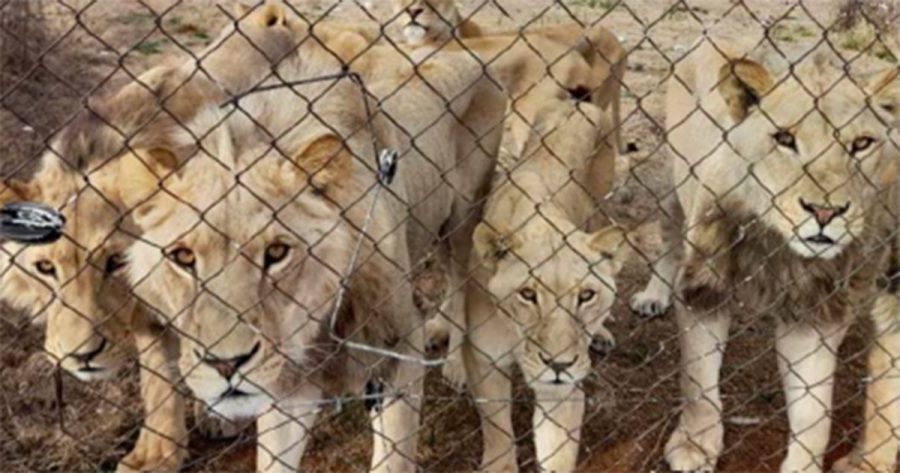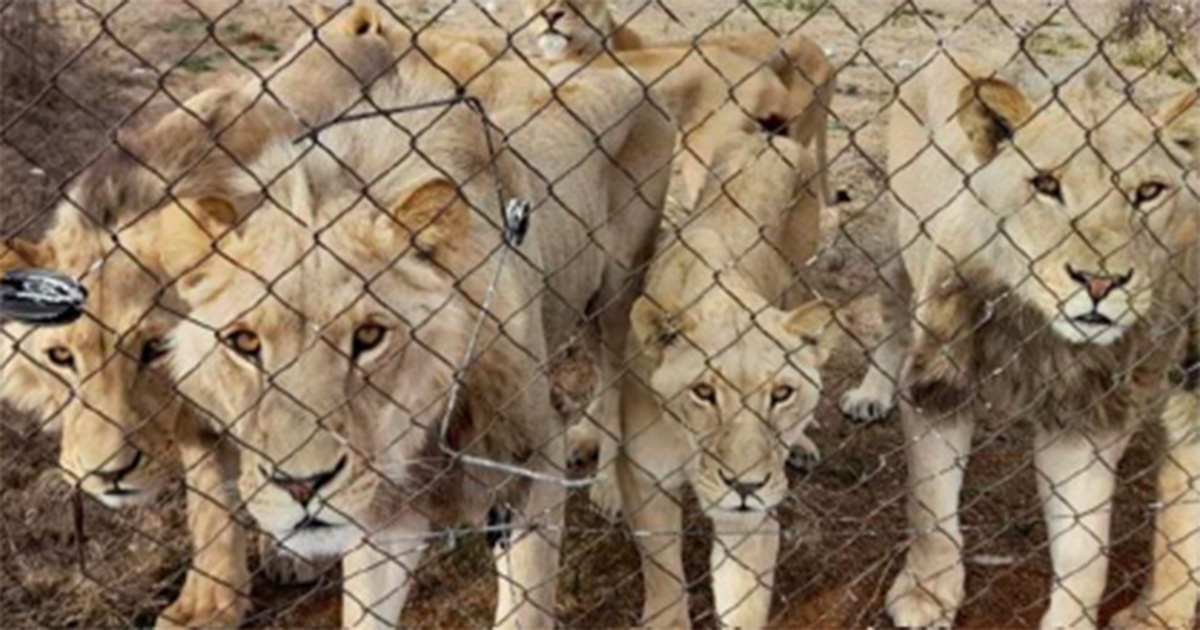
Parliament shocked by grisly report on captive lions in South Africa
South African parliamentarians were horrified by the cruelty NSPCA inspectors have to witness on lion breeding farms. Warning: this report contains graphic images. By DON PINNOCK – Conservation Action Trust. It was a briefing to Parliament’s Environment Portfolio Committee on captive lions. But, as NSPCA senior inspector Douglas Wolhuter began explaining the images he was […]

South African parliamentarians were horrified by the cruelty NSPCA inspectors have to witness on lion breeding farms. Warning: this report contains graphic images. By DON PINNOCK – Conservation Action Trust.

It was a briefing to Parliament’s Environment Portfolio Committee on captive lions. But, as NSPCA senior inspector Douglas Wolhuter began explaining the images he was putting on the screen, it became a horror show.
The levels of cruelty his team have been required to witness were sickening.
“The weight of evidence against the captive lion industry,” he said, “calls for its closure. It is irresponsible, inhumane and an unsustainable practice. It’s heartbreaking what our inspectors have to deal with.”
View photo: Chicken carcasses awaiting feeding time. (Photo: Supplied)
That evidence, he proceeded to show. Skeletal lions, small pens full of rotting bones, water troughs green with algae, cowering and disfigured cubs, disfigured limbs, fragile bones from a diet of nothing but birds from chicken farms, carcasses of lions killed by having their heads bashed in… images very hard to watch.
View photo: Food sourced from chicken hatcheries provides inadequate nutrition. (Photo: Supplied)
In a number of the 127 captive lion facilities inspected in 2022, the NSPCA found inadequate fencing and shelter, unhygienic conditions, inadequate fresh water, overstocking, inadequate diet, insufficient food, incompatible animals, piles of faecal mass, no environment enrichment or a lack of veterinary care.
However, although 21 warrants had been issued against 17 accused, because of the inadequacy of the judicial system, only one case was presently on trial.
View photo (Photo: Supplied)
“There is great difficulty in getting cases to court,” said Wolhuter. “Some cases in which charges were laid in 2019 are only now getting to the courts. What we need are specialised courts and a speedier justice system.
‘Huge hostility’
“We are also met with huge hostility on our inspections. If it’s a clean industry with nothing to hide, why would we be running into such opposition to getting on site? This is an industry that should be closed down. These lions have no conservation value.”
Although the NSPCA is responsible for enforcing the Animal Protection Act (1962) as an arm of government, it receives no government funding and faces almost insurmountable obstacles. These include provincial policy inconsistencies, a belief that the act is subordinate to provincial ordinances, and the snail’s pace of the judicial system.
Following the NSPCA presentation, representatives of the Wildlife Ranching Association and Professional Hunters Association scrambled to distance themselves from what the committee had just seen, claiming those were bad apples in a clean basket.
Richard York of Wildlife Ranching pointed out that lion breeding was a legal activity, the NSPCA had not inspected all places, and a blanket ban would penalise those operating ethically. Dr Paul Booyens related a successful rewilding of some captive-bred lions.
But acting chair of the Portfolio Committee, Phillip Modise, was unconvinced. The conditions the NSPCA had shown, he said, were despicable and must end.
“Do you think it’s fair for wild cats not to be allowed to be wild?” he asked.
‘Harm to Brand South Africa’
“It would be naive of us as a committee to think that the breeding of captive lions is not harmful to Brand South Africa. Time for debate is over… we need action.”
Although committee members expressed shock, they could not have been unaware of the situation.
 The meeting was the latest in a series of many such gatherings over many years. These have included a Parliamentary Colloquium on lion breeding, a High-Level Panel on the use of lions, a draft White Paper, draft prohibition, a draft policy position and a newly appointed task team.
The meeting was the latest in a series of many such gatherings over many years. These have included a Parliamentary Colloquium on lion breeding, a High-Level Panel on the use of lions, a draft White Paper, draft prohibition, a draft policy position and a newly appointed task team.
None of these has resulted in the prohibition of the hunting of captive-bred lions and export of their parts, the prevention of cub petting by tourists, or the prohibition of new breeding.
Environment Minister Barbara Creecy cautioned that, while her department supported the recommendations of the High-Level Panel on the closure of breeding operations, it had to follow due process.
“We need to first adopt the White Paper. I have not issued a quota for the export of lion derivatives [bones]so there has been no legal export, although there is an illegal trade.
“Remember, people are in this field because they wish to make money, but face policy uncertainty. We cannot simply outlaw certain activities.”
In terms of the task team’s remit, she said it was not required to inspect every facility, but only those who indicated they wished to exit voluntarily.
This, however, contradicts the terms of reference of her own Lion Task Team, which requires “an audit of existing and captive-bred facilities”, DA member David Bryant objected.
“That means those who are unwilling will escape scrutiny. No facilities should be exempt,” said Bryant.
The number of captive lions far exceeds those in the wild.
 The Department of Environment estimates there to be 3,300 wild lions in the country and 8,185 captive lions, though NGOs say the latter number could be as high as 12,000.
The Department of Environment estimates there to be 3,300 wild lions in the country and 8,185 captive lions, though NGOs say the latter number could be as high as 12,000.
They are spread over 380 breeding facilities, most in the North West, Free State and Limpopo.
As the debates and resolutions continue, trade in wild predators carries on unabated.
According to a Blood Lions report just released, between 2010 and 2020, South African breeders legally exported 5,354 wild cats:

These went to zoos, circuses, private collections, as hunting trophies and for “scientific and medical” purposes.
Most lions went to China, followed by Thailand, Pakistan and Vietnam, whereas most cheetahs went to the United States. China also imported the greatest number of leopards, caracals, servals, jaguars and pumas, while Vietnam took the most tigers.

Anecdotal reports exist of many breeding facilities in China for these species, which correlates with China’s established policy to end reliance on imports of all descriptions.
Ultimately, China will probably be able to satisfy local demand through its own lion breeding programme.
In its presentation to Parliament, the Conservation Action Trust listed various types of hunted lion exports, including full mounts, full skins, skulls and “floating bones”.

It pointed out that breeders, clearly aware of growing international distaste for hunting, were offering “cut-rate” hunts with websites saying, “Get your trophy lion while you still can!”
Professional hunting outfits are clearly using the Parliamentary debates as a marketing inducement. One hunt site warns: “South Africa has announced its intent to shut down CB [captive-bred] lion hunting and the shutdown is underway. The inventory of mature males is shrinking and the price is going up. This is your chance to get a big discount on a male lion.”
A 2021 investigation by the EMS Foundation and Ban Animal Trading, Breaking Point, found that the biggest threat to wild animals was not poaching, but the legal trade.

It noted that oversight by the UN trade organisation CITES was almost non-existent – export and import permits did not tally, animals were being shipped to criminal networks, traders were making false declarations, non-indigenous animals were being conduited through South Africa from elsewhere, and there was no destination-monitoring of exported animals.
The Parliamentary debate concluded with an agreement by the Committee to adopt the proposals by the Conservation Action Trust in its presentation. These were to:
- Implement the immediate actions recommended by the High-Level Panel on lions;
- Extend protections to all big cats in captivity; expedite cooperation between the departments of Environment and Agriculture on the issue of animal welfare;
- Use existing regulations to address the suffering of captive lions, and
- Convene an Animal Welfare Colloquium to discuss the adoption of a One Welfare principle for animals. DM/OBP
Original article: https://www.dailymaverick.co.za/article/2023-01-25-grisly-report-on-captive-lions-shocks-parliament/
Source: Conservation Action Trust
